Woodpeckers are fascinating birds known for their unique drumming behavior and ability to excavate holes in trees. In the state of Georgia, bird enthusiasts have the opportunity to spot a variety of woodpecker species. Whether you’re a seasoned birdwatcher or just starting out, exploring the diverse habitats of Georgia can offer a chance to observe these charismatic woodpeckers in their natural habitat.
In this article, we will delve into the fascinating world of woodpeckers in Georgia, highlighting the eight species that call the state their home. By examining their physical characteristics, habitats, and preferred food sources, you can gain valuable insights into the lives of these captivating birds and embark on your own woodpecker-watching journey in the beautiful state of Georgia.
There are 8 types of Woodpeckers in Georgia:
Red-headed Woodpecker

- Lifespan: Typically 9 to 19 years in the wild
- Size: Approximately 7.5 to 9.1 inches (19 to 23 cm)
- Weight: About 2.0 to 3.2 ounces (57 to 91 grams)
- Wingspan: Around 16.5 inches (42 cm)
- Status: Red-headed Woodpeckers are currently listed as near-threatened.
The Red-headed Woodpecker is a striking bird with a black and white body and a vibrant red head, giving it a distinctive appearance. This medium-sized woodpecker is commonly found in open woodlands, savannas, and orchards throughout Georgia. They have a varied diet consisting of insects, fruits, nuts, and seeds, and are known for their habit of caching food by wedging it into crevices or bark for later consumption.
Red-headed Woodpeckers are cavity nesters, creating their homes in the dead limbs of trees. They will also utilize artificial nest boxes if available. The female typically lays 4-7 eggs, and both parents take turns incubating the eggs and feeding the young. These woodpeckers are highly territorial during the breeding season and will defend their nesting sites aggressively.
Overall, the Red-headed Woodpecker is a beautiful and fascinating bird that adds color and life to the woodlands and rural landscapes of Georgia. Its striking appearance, varied diet, and unique nesting habits make it a valuable and charismatic species in the state’s ecosystem.
Downy woodpecker

- Lifespan: Up to 11 years in the wild
- Size: Approximately 6.7 to 7.9 inches (17 to 20 cm)
- Weight: About 0.7 to 1.0 ounces (20 to 28 grams)
- Wingspan: Around 9.8 to 12.2 inches (25 to 31 cm)
- Status: Downy Woodpeckers are considered a species of least concern.
The Downy Woodpecker is the smallest woodpecker in North America, measuring about 6-7 inches in length. In Georgia, they can be found in a variety of wooded habitats including forests, woodlots, and suburban areas with trees. Their diet consists mainly of insects such as beetles, ants, and caterpillars, as well as seeds and berries.
In the spring, Downy Woodpeckers excavate nest cavities in dead trees or limbs, often using small holes that they peck into the wood. Their typical calls include a sharp “pik” or “tchick” sound, as well as a drumming noise made by rapidly pecking on wood to establish territory or attract mates.
Common sightings of the Downy Woodpecker in Georgia include foraging on tree trunks and branches, as well as visiting backyard bird feeders for suet and sunflower seeds. Despite their small size, they are known for their distinct black-and-white plumage and their habit of drumming on trees to communicate with others of their kind.
Hairy woodpecker
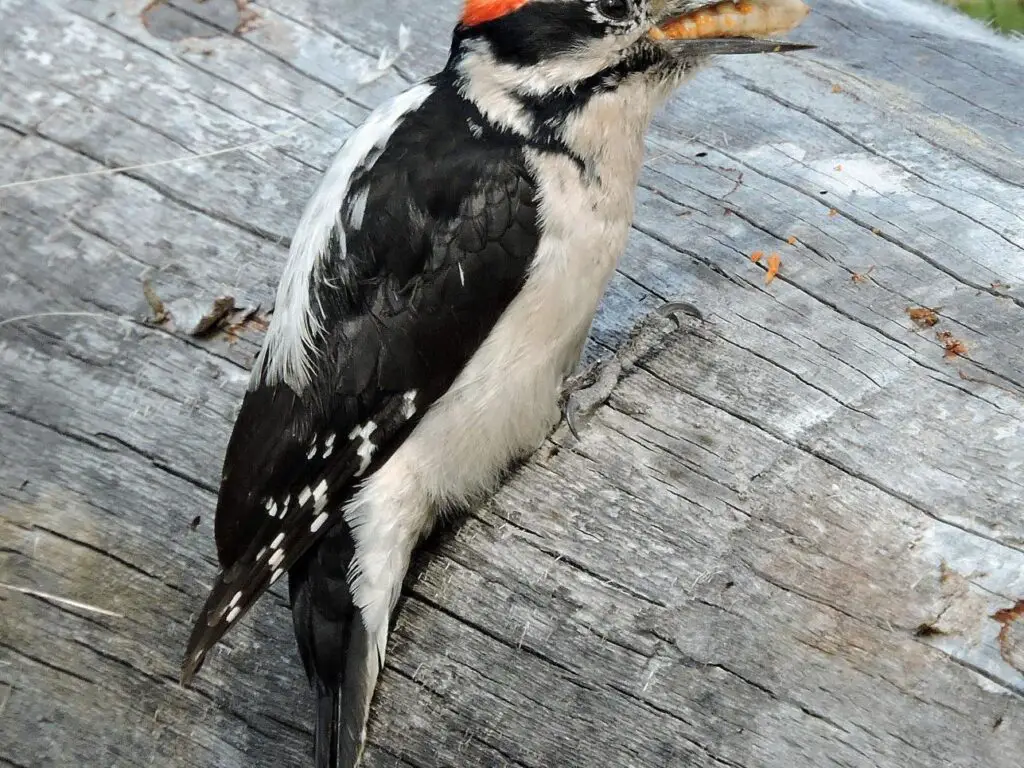
- Lifespan: Typically 4 to 9 years in the wild
- Size: Approximately 7 to 10.2 inches (18 to 26 cm)
- Weight: About 1.4 to 3.4 ounces (40 to 96 grams)
- Wingspan: Around 13 to 17 inches (33 to 43 cm)
- Status: Hairy Woodpeckers are considered a species of least concern.
The Hairy Woodpecker is a medium-sized bird found in Georgia with a length of 7-10 inches and a wingspan of 13-17 inches. They have black and white plumage, with a white belly, black wings with white spots, and a white stripe down the middle of their black back. The male Hairy Woodpecker can be distinguished from the female by the presence of a small red patch on the back of its head.
These woodpeckers prefer to nest in mature forests with a mix of hardwood and conifer trees. They typically excavate their nesting cavities in dead trees or snags, and forage for insects under the bark of trees.
To attract Hairy Woodpeckers to your yard, you can provide a variety of food sources such as suet, sunflower seeds, and peanuts. Maintaining dead trees and snags in your yard will also provide them with suitable nesting sites. Additionally, offering a water source such as a bird bath can attract these birds to your yard.
Key distinguishing features of the Hairy Woodpecker include its larger size compared to other woodpecker species, its black wings with white spots, and the small red patch on the back of the head of the male. When foraging, Hairy Woodpeckers tend to hitch up tree trunks and large branches, using their strong bills to chip away at the bark in search of insects.
You may also like:
Red-cockaded Woodpecker
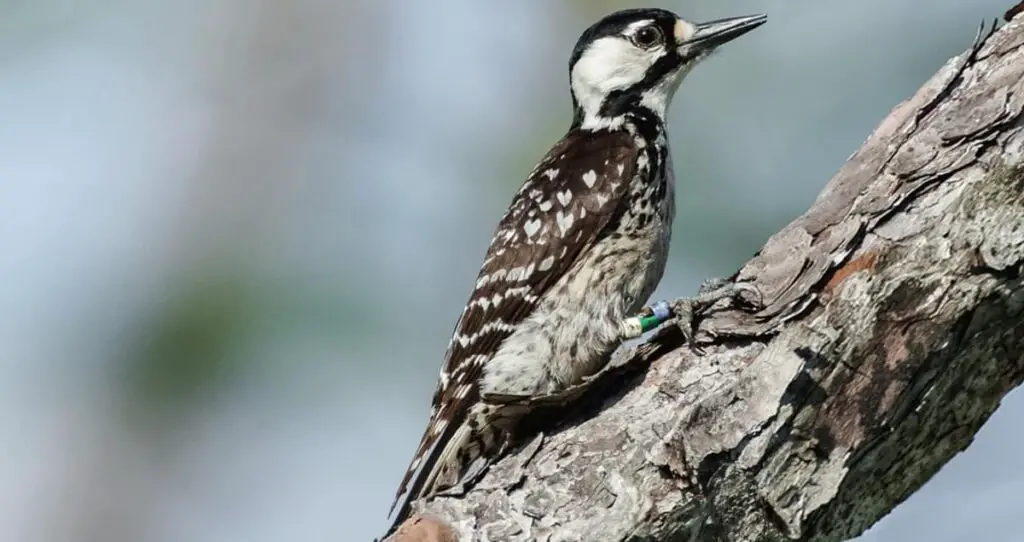
- Lifespan: Typically 4 to 11 years in the wild
- Size: Approximately 7 to 9 inches (18 to 23 cm)
- Weight: About 1.6 to 2.3 ounces (45 to 65 grams)
- Wingspan: Around 14 to 16 inches (36 to 41 cm)
- Status: The Red-cockaded Woodpecker is listed as endangered.
Red-cockaded woodpeckers can be identified by their distinctive black and white barred back, black cap, and small red streak on the side of their head (hence the name “red-cockaded”). To spot them in Georgia, you can visit key locations such as Webb Wildlife Center, Donnelley WMA, Piedmont NWR, Okefenokee NWR, and River Creek WMA.
These woodpeckers typically nest in mature pine forests, creating cavities in living pine trees. They primarily feed on insects, including beetles and ants, which they find by pecking and drilling into the bark of trees.
It’s crucial to protect the natural habitat of red-cockaded woodpeckers as they are an endangered species. Destruction of their mature pine forests, either through logging or development, has significantly contributed to their decline. Conservation efforts focused on preserving these habitats are essential for their survival in Georgia.
In conclusion, red-cockaded woodpeckers can be found in select areas of Georgia, nesting in mature pine forests and feeding on insects. Protecting their natural habitat is crucial for ensuring their continued existence in the region.
Yellow-bellied Sapsucker
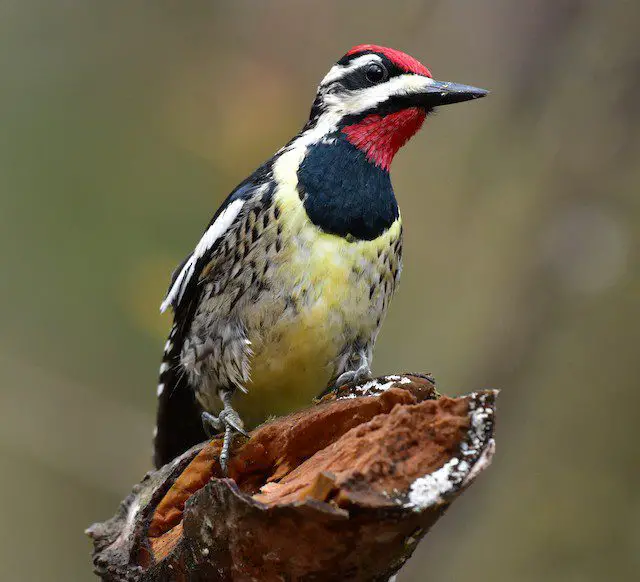
- Lifespan: Typically 4 to 7 years in the wild
- Size: Approximately 7 to 8.5 inches (18 to 22 cm)
- Weight: About 1.5 to 2.1 ounces (43 to 60 grams)
- Wingspan: Around 13 to 16 inches (33 to 41 cm)
- Status: Yellow-bellied Sapsuckers are considered a species of least concern.
The Yellow-bellied Sapsucker is a medium-sized woodpecker with distinctive black and white markings, a red crown, and a yellow wash on its belly. They can be found in mature forests and wooded areas throughout Georgia, particularly in the northern part of the state. Their winter habitat in Georgia includes mixed woodlands with a preference for trees such as birch, maple, and sycamore.
Yellow-bellied Sapsuckers have a unique feeding behavior as they feed on the sap of trees by drilling rows of small holes and then lapping up the sap and any insects that are attracted to it. They also consume insects, fruits, and berries. To attract them to your yard, consider offering a source of sap, suet, or fruit, as well as maintaining dead trees or snags for foraging and nesting. They may also be enticed by hummingbird feeders filled with sugar water.
In conclusion, the Yellow-bellied Sapsucker is a beautiful and unique woodpecker species found in Georgia, with distinct characteristics, habitat preferences, and feeding behavior. By providing the right resources, such as sap and suitable nesting sites, you can attract these fascinating birds to your yard.
You may also like:
Red-bellied Woodpecker

- Lifespan: Typically 9 to 12 years in the wild
- Size: Approximately 9 to 10.5 inches (23 to 27 cm)
- Weight: About 2.0 to 3.2 ounces (57 to 91 grams)
- Wingspan: Around 13 to 16.5 inches (33 to 42 cm)
- Status: Red-bellied Woodpeckers are considered a species of least concern.
The Red-bellied woodpecker, found in Georgia, is a medium-sized bird with distinctive physical characteristics. It has a red cap on its head, a red wash on its belly, and black and white barred wings. The male has a red patch on the back of its neck, while the female has a gray patch. Their vocalizations consist of a rolling series of “querr” notes and a rapid “churr” sound.
Red-bellied woodpeckers nest in tree cavities, often excavating their own nests in dead trees or using existing natural cavities. They also may use human-made birdhouses for nesting purposes. Their diet consists of insects, seeds, fruits, and nuts, and they are known to store food in crevices of trees for later consumption.
The population status of Red-bellied woodpeckers in Georgia is reported to be stable. Despite potential threats such as habitat loss, they have successfully adapted to urban and suburban environments and are commonly seen in backyards. Their ability to thrive in a variety of habitats has contributed to their stable population status in Georgia.
Pileated Woodpecker
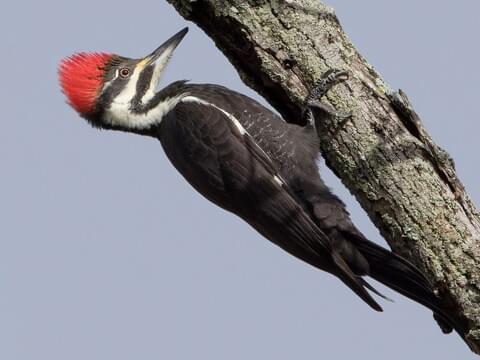
- Lifespan: Typically 7 to 10 years in the wild
- Size: Approximately 16 to 19 inches (40 to 49 cm)
- Weight: About 8.8 to 12.3 ounces (250 to 349 grams)
- Wingspan: Around 26 to 30 inches (66 to 76 cm)
- Status: Pileated Woodpeckers are considered a species of least concern.
The Pileated Woodpecker, native to Georgia, is recognizable by its large size, prominent red crest, and black and white striped face. They are primarily found in mature forests with large trees, especially in bottomland hardwoods, but can also be found in suburban areas with suitable habitat. Pileated Woodpeckers primarily feed on carpenter ants, beetles, and other wood-boring insects, using their strong bills to excavate deep into tree trunks.
These woodpeckers nest in large cavities in dead or partially dead trees, and prefer to excavate their own nesting sites. The population status of the Pileated Woodpecker is currently stable, with their population increasing in recent years due to suitable habitat availability.
Conservation status for the Pileated Woodpecker is of least concern, though possible threats include habitat loss due to logging and urbanization, and the decline of large, mature trees for nesting. Efforts to conserve and protect mature forests will help to ensure the continued stability of this iconic woodpecker species in Georgia.
Northern Flicker
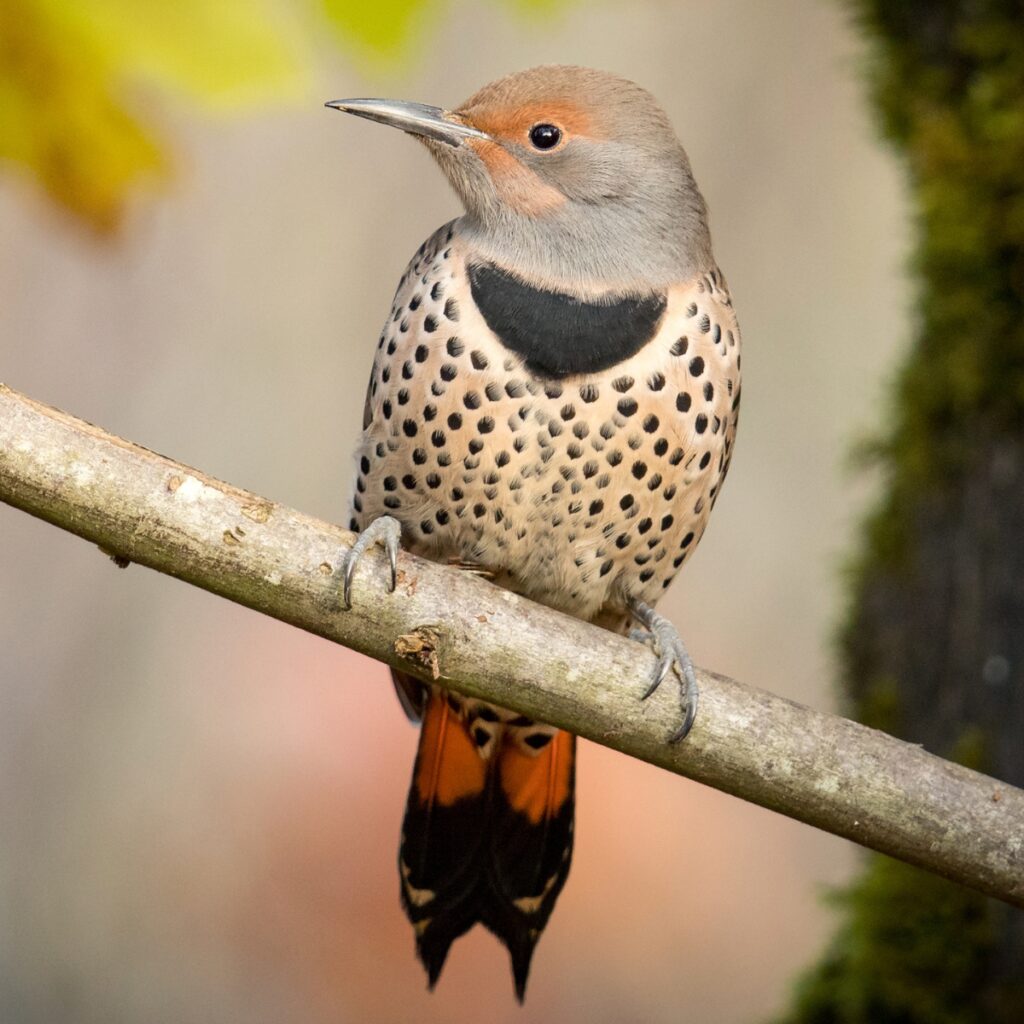
- Lifespan: Typically 6 to 8 years in the wild
- Size: Approximately 11 to 14 inches (28 to 36 cm)
- Weight: About 3.9 to 5.6 ounces (110 to 160 grams)
- Wingspan: Around 17 to 21 inches (43 to 53 cm)
- Status: Northern Flickers are considered a species of least concern.
The Northern Flicker, a type of woodpecker, can be found in Georgia with its key characteristics including a brown and gray plumage with a distinctive black crescent on its chest. They prefer woodlands and open areas with suitable trees for nesting and foraging. Their feeding habits include pecking at the ground for ants and beetles, as well as their unique behavior of spreading sticky tree sap on their feathers which acts as a natural insect repellent.
This behavior is thought to help protect the bird from parasites while they nest and care for their young. These flickers are known for their loud, repetitive calls and drumming on trees when searching for food or attracting a mate. In Georgia, they can be found in a variety of habitats including forests, woodlots, parks, and suburban areas with mature trees. Their distinctive appearance, preference for woodlands and open areas with suitable trees, and unique feeding behavior make the Northern Flicker a fascinating species to observe in its natural habitat.
Conclusion
In conclusion, the eight types of woodpeckers in Georgia are just one example of the incredible biodiversity that can be found in our state. Whether you are a birder or just a nature enthusiast, taking the time to learn about and appreciate these beautiful and unique birds is a truly rewarding experience. So grab your binoculars, head out into the forest, and get ready to spot some incredible woodpeckers in Georgia!



